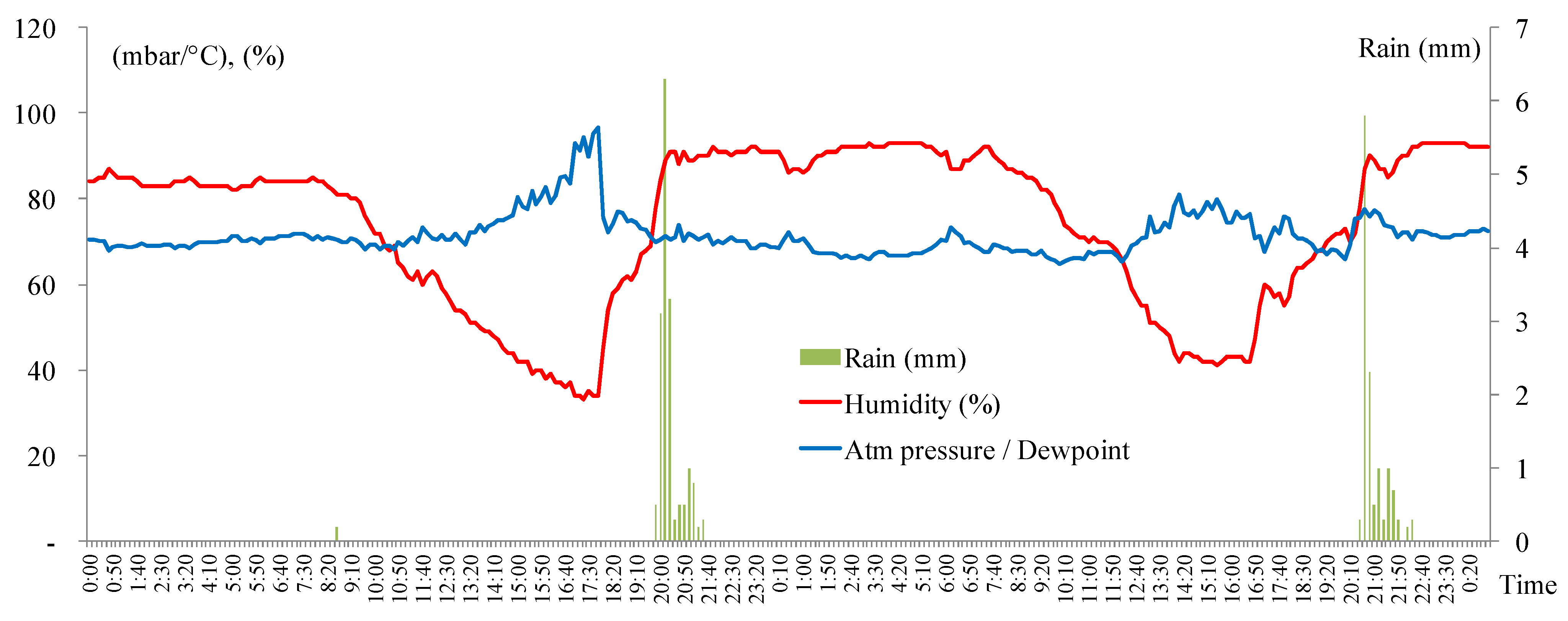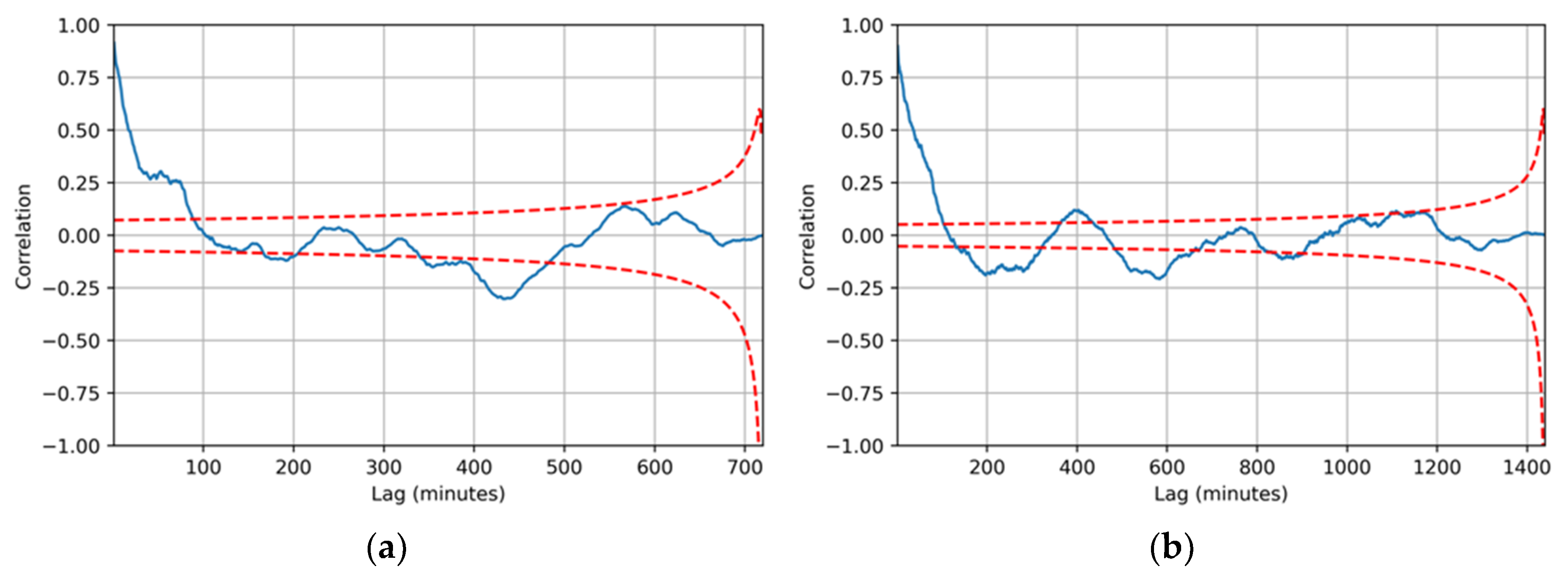Sensitivity Analysis of Start Point of Extreme Daily Rainfall Using CRHUDA and Stochastic Models
Abstract
1. Introduction
2. Materials and Methods
2.1. CRHUDA Proposed Model
2.2. Autoregressive Moving-Average Models ARMA(p,q)
2.3. Multivariate Stochastic Models
2.4. Autocorrelation as Validation of CRHUDA Model
2.5. Sensitivity Analysis
3. Results
3.1. Presentation of CRHUDA Model
3.2. Calculation of Correlograms
3.3. Calculation of Scaling Factor
4. Discussion
4.1. Calculation of Scaling Factor
4.2. Model Calibration, Validation and Precision
5. Conclusions
Author Contributions
Funding
Institutional Review Board Statement
Informed Consent Statement
Data Availability Statement
Acknowledgments
Conflicts of Interest
References
- Lepore, C.; Allen, J.T.; Tippett, M.K. Relationships between Hourly Rainfall Intensity and Atmospheric Variables over the Contiguous United States. J. Clim. 2016, 29, 3181–3197. [Google Scholar] [CrossRef]
- Vincent, L.A.; van Wijngaarden, W.A.; Hopkinson, R. Surface Temperature and Humidity Trends in Canada for 1953–2005. J. Clim. 2007, 20, 5100–5113. [Google Scholar] [CrossRef]
- CENAPRED. Disasters in Mexico: Social and Economic Impacts (1980–2014); Centro Nacional de Prevension de Desastres: Ciudad de Mexico, Mexico, 2016.
- Valverde Ramírez, M.C.; de Campos Velho, H.F.; Ferreira, N.J. Artificial neural network technique for rainfall forecasting applied to the São Paulo region. J. Hydrol. 2005, 301, 146–162. [Google Scholar] [CrossRef]
- Zahraei, A.; Hsu, K.-L.; Sorooshian, S.; Gourley, J.J.; Hong, Y.; Behrangi, A. Short-term quantitative precipitation forecasting using an object-based approach. J. Hydrol. 2013, 483, 1–15. [Google Scholar] [CrossRef]
- Egerer, M.H.; Lin, B.B.; Kendal, D. Temperature Variability Differs in Urban Agroecosystems across Two Metropolitan Regions. Climate 2019, 7, 50. [Google Scholar] [CrossRef]
- Emmanuel, L.A.; Hounguè, N.R.; Biaou, C.A.; Badou, D.F. Statistical Analysis of Recent and Future Rainfall and Temperature Variability in the Mono River Watershed (Benin, Togo). Climate 2019, 7, 8. [Google Scholar] [CrossRef]
- Gutierrez-Lopez, A. A Robust Gaussian variogram estimator for cartography of hydrological extreme events. Nat. Hazards 2021, 107, 1469–1488. [Google Scholar] [CrossRef]
- Rogers, J.C.; Wang, S.-H.; Coleman, J.S.M. Evaluation of a Long-Term (1882–2005) Equivalent Temperature Time Series. J. Clim. 2007, 20, 4476–4485. [Google Scholar] [CrossRef][Green Version]
- Millán, H.; Ghanbarian-Alavijeh, B.; García-Fornaris, I. Nonlinear dynamics of mean daily temperature and dewpoint time series at Babolsar, Iran, 1961–2005. Atmos. Res. 2010, 98, 89–101. [Google Scholar] [CrossRef]
- Mohr, S.; Kunz, M. Recent trends and variabilities of convective parameters relevant for hail events in Germany and Europe. Atmos. Res. 2013, 123, 211–228. [Google Scholar] [CrossRef]
- Dahm, R.; Bhardwaj, A.; Weiland, F.S.; Corzo, G.; Bouwer, L.M. A Temperature-Scaling Approach for Projecting Changes in Short Duration Rainfall Extremes from GCM Data. Water 2019, 11, 313. [Google Scholar] [CrossRef]
- Damrath, U.; Doms, G.; Frühwald, D.; Heise, E.; Richter, B.; Steppeler, J. Operational quantitative precipitation forecasting at the German Weather Service. J. Hydrol. 2000, 239, 260–285. [Google Scholar] [CrossRef]
- Polotzek, K.; Kantz, H. An ARFIMA-based model for daily precipitation amounts with direct access to fluctuations. Stoch. Environ. Res. Risk Assess. 2020, 34, 1487–1505. [Google Scholar] [CrossRef]
- Gil-Alana, L.A.; Martin-Valmayor, M.A.; Hube-Antoine, C. An analysis of temperature anomalies in Chile using fractional integration. Stoch. Environ. Res. Risk Assess. 2023, 37, 2713–2724. [Google Scholar] [CrossRef]
- Gutierrez-Lopez, A.; Cruz-Paz, I.; Mandujano, M.M. Algorithm to Predict the Rainfall Starting Point as a Function of Atmospheric Pressure, Humidity, and Dewpoint. Climate 2019, 7, 131. [Google Scholar] [CrossRef]
- Gutierrez-Lopez, A.; Trejo, M.F.; Gonzalez, N.I.A.; Prado, F.B. Análisis de la variabilidad espacial en la precipitación en la zona metropolitana de Querétaro empleando ecuaciones de anisotropía. Investig. Geográficas 2019, 99, 1–16. [Google Scholar] [CrossRef]
- Shaw, S.B.; Royem, A.A.; Riha, S.J. The Relationship between Extreme Hourly Precipitation and Surface Temperature in Different Hydroclimatic Regions of the United States. J. Hydrometeorol. 2011, 12, 319–325. [Google Scholar] [CrossRef]
- Agard, V.; Emanuel, K. Clausius–Clapeyron Scaling of Peak CAPE in Continental Convective Storm Environments. J. Atmos. Sci. 2017, 74, 3043–3054. [Google Scholar] [CrossRef]
- Lorenz, D.J.; DeWeaver, E.T. The Response of the Extratropical Hydrological Cycle to Global Warming. J. Clim. 2007, 20, 3470–3484. [Google Scholar] [CrossRef]
- Camuffo, D. Theoretical Grounds for Humidity. In Microclimate for Cultural Heritage; Elsevier: Amsterdam, The Netherlands, 2014; Chapter 2A; pp. 49–76. ISBN 9780444632982. [Google Scholar] [CrossRef]
- Romps, D.M. An Analytical Model for Tropical Relative Humidity. J. Clim. 2014, 27, 7432–7449. [Google Scholar] [CrossRef]
- Holley, D.M.; Dorling, S.R.; Steele, C.J.; Earl, N. A climatology of convective available potential energy in Great Britain. Int. J. Clim. 2014, 34, 3811–3824. [Google Scholar] [CrossRef]
- Chang, W.; Stein, M.L.; Wang, J.; Kotamarthi, V.R.; Moyer, E.J. Changes in Spatiotemporal Precipitation Patterns in Changing Climate Conditions. J. Clim. 2016, 29, 8355–8376. [Google Scholar] [CrossRef]
- Lenderink, G.; Barbero, R.; Loriaux, J.M.; Fowler, H.J. Super-Clausius–Clapeyron Scaling of Extreme Hourly Convective Precipitation and Its Relation to Large-Scale Atmospheric Conditions. J. Clim. 2017, 30, 6037–6052. [Google Scholar] [CrossRef]
- Bürger, G.; Heistermann, M.; Bronstert, A. Towards Subdaily Rainfall Disaggregation via Clausius–Clapeyron. J. Hydrometeorol. 2014, 15, 1303–1311. [Google Scholar] [CrossRef]
- Peleg, N.; Marra, F.; Fatichi, S.; Molnar, P.; Morin, E.; Sharma, A.; Burlando, P. Intensification of Convective Rain Cells at Warmer Temperatures Observed from High-Resolution Weather Radar Data. J. Hydrometeorol. 2018, 19, 715–726. [Google Scholar] [CrossRef]
- Velasco, S.; Fernández-Pineda, C. Sobre la obtención de la ecuación de Clapeyron-Clausius. Rev. Española Física 2008, 22, 7–14. [Google Scholar]
- Seidel, T.M.; Grant, A.N.; Pszenny, A.A.P.; Allman, D.J. Dewpoint and Humidity Measurements and Trends at the Summit of Mount Washington, New Hampshire, 1935–2004. J. Clim. 2007, 20, 5629–5641. [Google Scholar] [CrossRef]
- Harder, P.; Pomeroy, J. Estimating precipitation phase using a psychrometric energy balance method. Hydrol. Process. 2013, 27, 1901–1914. [Google Scholar] [CrossRef]
- Box GE, P.; Jenkins, G.M. Time Series Analysis: Forecasting and Control; Holden-Day: San Francisco, CA, USA, 1976; ISBN 9780816211043. [Google Scholar]
- Sim, I.; Lee, O.; Kim, S. Sensitivity Analysis of Extreme Daily Rainfall Depth in Summer Season on Surface Air Temperature and Dew-Point Temperature. Water 2019, 11, 771. [Google Scholar] [CrossRef]
- Danladi, A.; Stephen, M.; Aliyu, B.; Gaya, G.; Silikwa, N.; Machael, Y. Assessing the influence of weather parameters on rainfall to forecast river discharge based on short-term. Alex. Eng. J. 2018, 57, 1157–1162. [Google Scholar] [CrossRef]
- Li, P.; Lai, E.S. Short-range quantitative precipitation forecasting in Hong Kong. J. Hydrol. 2004, 288, 189–209. [Google Scholar] [CrossRef]
- Moon, S.-H.; Kim, Y.-H.; Lee, Y.H.; Moon, B.-R. Application of machine learning to an early warning system for very short-term heavy rainfall. J. Hydrol. 2019, 568, 1042–1054. [Google Scholar] [CrossRef]
- Segond, M.-L.; Onof, C.; Wheater, H. Spatial–temporal disaggregation of daily rainfall from a generalized linear model. J. Hydrol. 2006, 331, 674–689. [Google Scholar] [CrossRef]
- Dyson, L.L.; van Heerden, J.; Sumner, P.D. A baseline climatology of sounding-derived parameters associated with heavy rainfall over Gauteng, South Africa. Int. J. Clim. 2014, 35, 114–127. [Google Scholar] [CrossRef]
- Berg, P.; Haerter, J. Unexpected increase in precipitation intensity with temperature—A result of mixing of precipitation types? Atmos. Res. 2013, 119, 56–61. [Google Scholar] [CrossRef]
- Park, I.-H.; Min, S.-K. Role of Convective Precipitation in the Relationship between Subdaily Extreme Precipitation and Temperature. J. Clim. 2017, 30, 9527–9537. [Google Scholar] [CrossRef]










| Storm Date | |||||
|---|---|---|---|---|---|
| 8 September 2013 | 1.23 | 16:40:00 | 0:13:00 | 16:37:00 | 0:03:00 |
| 16 September 2013 | 1.31 | 15:15:00 | 0:06:00 | 14:51:00 | 0:24:00 |
| 21 September 2013 | 1.28 | 13:54:46 | 0:44:14 | 13:54:16 | 0:00:30 |
| 25 September 2016 | 1.24 | 15:37:00 | 0:05:00 | 15:36:00 | 0:01:00 |
| 17 September 2017 | 0.72 | 0:00:00 | 0:00:00 | 0:00:00 | 0:00:00 |
| 26 September 2017 | 0.93 | 19:26:00 | 1:40:00 | 19:12:00 | 0:14:00 |
| 9 September 2018 | 1.24 | 21:18:00 | 0:39:00 | 21:16:00 | 0:02:00 |
| 19 September 2019 | 1.14 | 20:52:00 | 0:02:00 | 11:41:00 | 9:11:00 |
| 29 September 2019 | 1.22 | 18:10:00 | 0:18:00 | 18:08:00 | 0:02:00 |
| 7 September 2021 | 0.77 | 18:17:00 | 0:13:00 | 10:27:00 | 7:50:00 |
Disclaimer/Publisher’s Note: The statements, opinions and data contained in all publications are solely those of the individual author(s) and contributor(s) and not of MDPI and/or the editor(s). MDPI and/or the editor(s) disclaim responsibility for any injury to people or property resulting from any ideas, methods, instructions or products referred to in the content. |
© 2024 by the authors. Licensee MDPI, Basel, Switzerland. This article is an open access article distributed under the terms and conditions of the Creative Commons Attribution (CC BY) license (https://creativecommons.org/licenses/by/4.0/).
Share and Cite
Muñoz-Mandujano, M.; Gutierrez-Lopez, A.; Acuña-Garcia, J.A.; Ibarra-Corona, M.A.; Aguilar, I.C.; Vargas-Diaz, J.A. Sensitivity Analysis of Start Point of Extreme Daily Rainfall Using CRHUDA and Stochastic Models. Stats 2024, 7, 160-171. https://doi.org/10.3390/stats7010010
Muñoz-Mandujano M, Gutierrez-Lopez A, Acuña-Garcia JA, Ibarra-Corona MA, Aguilar IC, Vargas-Diaz JA. Sensitivity Analysis of Start Point of Extreme Daily Rainfall Using CRHUDA and Stochastic Models. Stats. 2024; 7(1):160-171. https://doi.org/10.3390/stats7010010
Chicago/Turabian StyleMuñoz-Mandujano, Martin, Alfonso Gutierrez-Lopez, Jose Alfredo Acuña-Garcia, Mauricio Arturo Ibarra-Corona, Isaac Carpintero Aguilar, and José Alejandro Vargas-Diaz. 2024. "Sensitivity Analysis of Start Point of Extreme Daily Rainfall Using CRHUDA and Stochastic Models" Stats 7, no. 1: 160-171. https://doi.org/10.3390/stats7010010
APA StyleMuñoz-Mandujano, M., Gutierrez-Lopez, A., Acuña-Garcia, J. A., Ibarra-Corona, M. A., Aguilar, I. C., & Vargas-Diaz, J. A. (2024). Sensitivity Analysis of Start Point of Extreme Daily Rainfall Using CRHUDA and Stochastic Models. Stats, 7(1), 160-171. https://doi.org/10.3390/stats7010010







